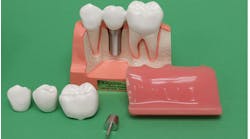The number of dental practices with two or more owners is growing. If Dr. Senior plans to admit Dr. Junior as an owner, all parties should be aware of the tax risks that the Internal Revenue Service thinks are important under three common business and tax structure choices.
Stock including goodwill
The sale and purchase of stock in a professional corporation that includes goodwill is the only business and tax structure without any tax risks, and it allows for a cash buy-out of Dr. Senior in a two-owner practice. Unfortunately, it is also the one least used. Under this structure, Dr. Junior pays income tax on all compensation earned and then pays for the stock with after-tax or nondeductible dollars, while Dr. Senior receives favorable capital gains treatment.
Stock including goodwill works well from an economic perspective when the tax-neutral valuation of the practice is adjusted downward. This accounts for Dr. Junior paying for stock without any ability to deduct the purchase price and Dr. Senior receiving all capital gains. The downward adjustment applies to both the buy‑in and buy‑out formula. When Dr. Junior sells his or her stock in the future, he or she only pays capital gains above the purchase price paid or Dr. Junior's basis in the stock.
Stock including goodwill is understandable to doctors and advisors. It’s also very easy for the doctors to purchase life insurance that complements the future stock buy‑out.
You might also be interested in: Setting a buy-out price without appraisal; collections levels and hiring an associate
Stock excluding goodwill
The buy-in: compensation shifts and personal goodwill: The sale and purchase of stock excluding goodwill is often the pro rata fair market value of the tangible assets, coupled with a compensation shift to Dr. Senior that represents Dr. Senior's goodwill. In exchange for selling a fractional interest in his or her goodwill to Dr. Junior, Dr. Senior receives additional compensation as payment for the goodwill purchased, and Dr. Junior's shareholder compensation is reduced by the additional compensation to Dr. Senior.
The sale of stock is characterized as capital gains to Dr. Senior and is nondeductible to Dr. Junior. The additional compensation is characterized as ordinary income to Dr. Senior and represents a pretax buy‑in for Dr. Junior. The value of Dr. Senior's goodwill will be far greater than the value of the tangible assets. As a result, the compensation shift payable to Dr. Senior is increased to balance the tax differential. In addition, interest cannot be paid on the compensation shift and the sum is often increased for an interest component.
Although compensation shifts have not yet presented tax problems in the buy‑in of the transaction,1 assuming the compensation shifted equates to administrative and management services provided by Dr. Senior,2 a problem does arise in the buy-out. Dr. Senior is paid overtime in the form of deferred compensation rather than cash. As a result, there is a risk of default on the unpaid balance as deferred compensation is an unsecured promise to pay Dr. Senior compensation over time.
Rather than using a combination of stock excluding goodwill and a compensation shift, some advisors say that Dr. Junior should individually purchase a pro rata interest in the practice's or Dr. Senior's personal goodwill for the buy‑in. This method is not feasible because goodwill is not deductible to an individual who is not a trade or business.3 It is deductible only to the practice, which means that the goodwill is not deductible to Dr. Junior, who is buying into the practice.
The buy-out: deferred compensation and personal goodwill: If the buy-in is structured as the purchase and sale of stock excluding goodwill, the buy-out should be structured the same, that is, Dr. Senior's stock, excluding goodwill, is purchased by the corporation or Dr. Junior. The corporation continues to pay Dr. Senior deferred compensation,4 which represents Dr. Senior's remaining goodwill.
While payments for deferred compensation are deductible to the practice, they are taxable as ordinary income to Dr. Senior. Moreover, deferred compensation arrangements are now subject to the complexities of Internal Revenue Code (IRC) Section 409A and its harsh penalties for noncompliance. The primary effects to the practice are strict rules on payments and no ability to prepay the deferred compensation. For Dr. Senior, the buy‑out is not fully payable in cash, but over time with little security. While being paid overtime works well with a family member who succeeds Dr. Senior, Dr. Senior may want to be more cautious with Dr. Junior, who is not related.
Another buy‑out structure, which is supported by case law for a fractional purchase of goodwill,5 is a pro rata purchase of Dr. Senior's stock excluding goodwill. The practice, which is a trade or business,6 purchases a pro rata interest in Dr. Senior's goodwill.
The sale and purchase of personal goodwill in a buy-out is not without problems. First, if personal goodwill is part of the transaction, Dr. Senior cannot have a written agreement that he or she will be subject to a restrictive covenant with the practice upon Dr. Junior's buy‑out. If Dr. Senior does not have a restrictive covenant with the purchaser, which in co‑ownership is Dr. Senior's practice, there is not personal goodwill.7 This effectively eliminates this business and tax structure because Dr. Junior should require Dr. Senior be subject to a restrictive covenant.8 Second, if the practice was formed prior to August 10, 1993, the goodwill is not deductible.9 Finally, if personal goodwill is used for the buy-out, it is very important to have an appraisal that allocates Dr. Senior's personal goodwill versus any corporate goodwill.10
The three-entity method
An increasingly common business and tax structure for co-ownership involves Dr. Junior forming an S‑corporation and purchasing a pro rata interest in the tangible assets and goodwill from Dr. Senior's practice entity or from Dr. Senior. After the purchase, the two doctors operate the practice through a newly formed limited or professional limited liability company (LLC) taxed as a partnership. The LLC collects the revenue, pays the operating expenses including employee benefits, and employs the staff. Profits are distributed by the LLC to the respective S‑corporations, which are owned by Dr. Senior and Dr. Junior, and which pay the direct business expenses of each owner.
This method is favored by some advisors to change a tax unfriendly business and tax structure to one that is tax-neutral or asset treatment. Asset treatment occurs in a complete practice sale and purchase of tangible assets and goodwill. Dr. Senior receives primarily capital gains for the sale of goodwill (by far the largest asset in a complete sale and purchase), and Dr. Junior deducts all assets purchased, including goodwill.
Another reason advisors favor the three-entity method is that there is no co-ownership of the existing practice entity, which some advisors think may carry potential liability to Dr. Junior. But personal liability to Dr. Junior is unlikely because the practice and Dr. Senior hold Dr. Junior harmless from any liabilities that arose before the partnership. Ironically, Dr. Senior and Dr. Junior will be equal owners of the third entity through their respective S-corporations or other business entities.
The anti-churning rules: If Dr. Senior's practice was formed prior to August 10, 1993, the buy‑in and buy‑out under the three-entity method, as well as any purchase of Dr. Senior's personal goodwill, is subject to IRC Section 197 anti-churning rules. These deny amortization of the goodwill purchased by Dr. Junior11 if the two doctors jointly own 20% or more of the third entity12 or are family members, such as a son or daughter dentist. It is the LLC that creates a problem for nonrelated owners because 20% or more common ownership makes Dr. Senior and Dr. Junior related parties. IRC Section 197 does not separate the before and after August 10, 1993, goodwill.13 The IRS is aware of this situation and can track asset sales through Form 8594, which must be filed by Dr. Senior, Dr. Senior's practice entity, and Dr. Junior.
If Dr. Senior and Dr. Junior operate separate practices under a solo group arrangement with no common ownership of a third entity, the goodwill is amortizable for the buy‑in and buy‑out, except for family members. Each separate practice may adopt its own tax-qualified retirement and/or group health plans without covering the eligible employees of both practices. Shared employees are permitted under solo group arrangements.
Notwithstanding the ability to amortize pre-August 10, 1993, goodwill, solo groups work well, and Dr. Junior is usually not required to purchase Dr. Senior's practice upon Dr. Senior's retirement but has the option to do so. Because the practices are separate, Dr. Senior can sell his or her practice to a third party if Dr. Junior does not purchase. However, death or permanent disability usually requires a mandatory purchase by a remaining practice owner. Solo group arrangements usually do not work well for specialty practices, although multiple specialties are exceptions.
There are three exceptions to the anti-churning rules. The first is the gain recognition exception.14 Here, the practice entity would not be related to Dr. Senior, except for the substitution of more than 20% ownership and if Dr. Senior pays federal income tax at the highest ordinary income tax rate. Because Dr. Senior is taxed as ordinary income, the sale and purchase price is adjusted upward to balance the tax differential. The gain recognition exception is similar to stock excluding goodwill without deferred compensation needing to be paid to Dr. Senior.
The second exception is that the anti-churning rules are not applicable in the event of a death where Dr. Junior obtains a step-up basis under IRC Section 1014(a).15 The step-up in basis means that Dr. Senior's goodwill is stepped up to fair market value on the date of death, which allows Dr. Junior to amortize or deduct the goodwill as if he or she is unrelated to Dr. Senior and has purchased the goodwill for fair market value.
The third exception is Example 19 of the IRC Section 197 Regulations,16 which provides a method to avoid the anti-churning rules. One illustration of Example 19 involves Dr. Senior and his or her corporation forming a partnership or LLC at least one year before the pro rata sale of a partnership interest to Dr. Junior. The corporation transfers its tangible assets and any goodwill to the LLC, and Dr. Senior transfers any of his or her personal goodwill to the LLC. The partnership then makes an IRC Section 754 tax election and, at least one tax year later, Dr. Senior sells a partnership interest to Dr. Junior. While there is authority under Example 19 to avoid the anti-churning rules, there is also authority for the IRS to recast the transaction,16 which makes the use of this exception a little uncomfortable.
The anti-abuse rules: The anti-abuse rules17 provide that a taxpayer cannot amortize any Section 197 intangibles acquired in a transaction in which the principal purpose was either to avoid the requirement of the intangible acquired after August 10, 1993, or to avoid any of the anti-churning rules. If detected on audit, the IRS would attempt to recast the transaction as having a principal purpose of avoiding the anti-churning rules, unless the LLC was not formed incident to the sale of part of the practice to Dr. Junior.
The IRS has maintained that Section 197 is a statutory provision that only Congress can repeal, and it remains current law and must be enforced.18
Summary and thoughts
If Dr. Senior is contemplating Dr. Junior as a co-owner, or the two are now co-owners, the tax risks must be understood and avoided. If Drs. Senior and Junior are already co‑owners, they should consider revising the ownership agreements to comply with the tax laws.
Stock including goodwill: Because the stock is not deductible to Dr. Junior and Dr. Senior receives capital gains treatment, the co-ownership structure as stock, including goodwill with a downward adjustment for the buy-in price and buy-sell agreement formula, should be considered. It’s simple. There are no tax risks and there is one entity.
Stock excluding goodwill: Compensation shifts are workable provided there is an upward adjustment to the buy‑in price and buy-out formula. The purchase of an undivided half interest in Dr. Senior's personal goodwill by Dr. Junior individually will not work. For the buy‑out, stock excluding goodwill coupled with deferred compensation works well provided Dr. Senior understands that the payments will be made over time with little security for payment. Stock excluding goodwill coupled with the professional corporation's purchase of Dr. Senior's personal goodwill is not viable because Dr. Senior cannot have a restrictive covenant with his or her corporation, but must have a restrictive covenant with the practice, which is the purchaser.
Three-entity method: The three-entity method works well, notwithstanding the complexity and increased accounting costs of operating three entities if the practice was formed after August 10, 1993, and the doctors are not related. There is no adjustment to the buy-in price or buy-out formula due to asset treatment. If the practice was formed prior to August 10, 1993, the goodwill sold is not amortizable or deductible to Dr. Junior for the buy-in or buy-out. Solo group arrangements provide a good alternative to allow goodwill to be amortized where it otherwise would not be.
Expect advisors to keep the IRS in mind when developing the business and tax structure for co-ownership for Dr. Junior's buy‑in and Dr. Senior's buy‑out, or the buy-out of any owner for any reason.
Editor's note: This article appeared in the May 2023 print edition of Dental Economics magazine. Dentists in North America are eligible for a complimentary print subscription. Sign up here.
References
- Cavitch Z. Tax Planning for Corporations and Shareholders, 2nd Edition. International Institute of Technology, Inc. March 1, 1993.
- Pediatric Surgical Associates, PC v. Commissioner, T.C. Memo 2011-81, April 2, 2001; Mulcahy, Pauritsch, Salvador & Co., Ltd. v. Comm., 109 AFTR 2d 2012-XXXX, 05/17/2012.
- Internal Revenue Code (IRC) Reg. 1.212-1; Harry R. Haury v. Commissioner, T.C. Memo 2012-215.
- Revenue Ruling 60-31.
- This technical advice memorandum and revenue ruling recognize the partial transfer of personal goodwill: TAM 200244009; Revenue Rule 70-45.
- These recent cases recognize the existence of personal goodwill: Muskat v. U.S.; 554 F.3d 183; Solomon v. Commissioner, T.C. Memo. 2008-102, 208 WL 1744406 (U.S. Tax Ct.).
- Martin Ice Cream v. Commissioner, 110 T.C. No. 189 (1998); Norwalk v. Commissioner, T.C.N. 1998-279; Howard v. U.S., 2010 WL 3061626 (E.D. Wash. July 30, 2010); United States Court of Appeals for the 9th Circuit, No. 10‑35768, D.C. 2:08-cv-00365-RMP.
- Bryden v. CIR, T.C. Memo 1959-184.
- IRC Section 197.
- Kennedy v. Cir.C. Memo 2010-206.
- IRC Section 197(f)(9)(A)(i); IRC Reg. 1.197-2(h)(2)(i).
- IRC Reg. 1.197-2(h)(6)(i)(A).
- Ginsberg MD, Levin JS, Rocap DE. Mergers, Acquisitions, and Buyouts. Aspen Publications; December 2002.
- Section 197(f)(9)(B) and Treas. Reg. Section 1.197-1(H)(9).
- IRC Section 197(f)(9)(D) and Treas. Reg. Section 1.197-2(H)(5)(i).
- Reg. Section 1.197-2(k), Example 19.
- Reg. Section 1.197-2(j).
- Section 197 and Personal Goodwill in Professional Practices, May 13, 2019, Washington DC.






